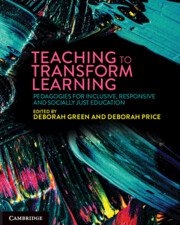Book contents
- Teaching to Transform Learning
- Acknowledgement of Country
- Teaching to Transform Learning
- Copyright page
- Contents
- Contributors
- Acknowledgements
- Introduction Understanding the learner to inform educators’ implementation of pedagogical approaches to transform learning
- Part 1 Pedagogies for all
- Part 2 Engaging pedagogies: making the curriculum come alive for all learners
- Part 3 Empowering pedagogies: 21st-century skill development and 22nd-century futures thinking
- 15 Understanding the world through transdisciplinary inquiry
- 16 Citizenship education: a relational approach
- 17 Flipping constructivist pedagogies to enable the equal intensity of depth and breadth in learning
- Index
- References
15 - Understanding the world through transdisciplinary inquiry
from Part 3 - Empowering pedagogies: 21st-century skill development and 22nd-century futures thinking
Published online by Cambridge University Press: 25 October 2024
- Teaching to Transform Learning
- Acknowledgement of Country
- Teaching to Transform Learning
- Copyright page
- Contents
- Contributors
- Acknowledgements
- Introduction Understanding the learner to inform educators’ implementation of pedagogical approaches to transform learning
- Part 1 Pedagogies for all
- Part 2 Engaging pedagogies: making the curriculum come alive for all learners
- Part 3 Empowering pedagogies: 21st-century skill development and 22nd-century futures thinking
- 15 Understanding the world through transdisciplinary inquiry
- 16 Citizenship education: a relational approach
- 17 Flipping constructivist pedagogies to enable the equal intensity of depth and breadth in learning
- Index
- References
Summary
This chapter will examine how a transdisciplinary approach to curriculum design provides a context for the development of intercultural awareness, fosters conceptual understanding and places the learner at the heart of the educational experience. A theoretical basis for transdisciplinary learning will first be presented. This will be followed by an analysis of the nature of the individual in the learning process and how this relates to the development of a global mindset. The chapter will conclude by offering practical considerations for the planning, teaching and assessing of learning through a transdisciplinary approach.
Keywords
- Type
- Chapter
- Information
- Teaching to Transform LearningPedagogies for Inclusive, Responsive and Socially Just Education, pp. 242 - 257Publisher: Cambridge University PressPrint publication year: 2024

